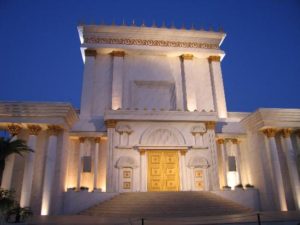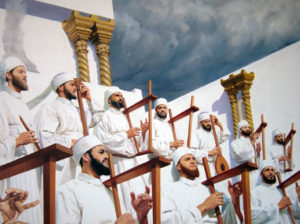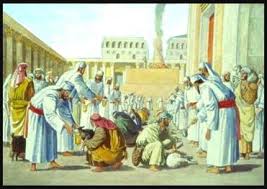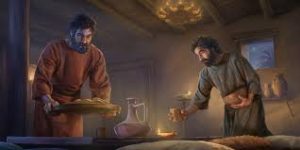Go and Make Preparations for the Passover
Matthew 26:17-19; Mark 14:12-16; Luke 22:7-13; John 13:1
Thursday the fourteenth of Nisan, and Friday the Fifteenth of Nisan
Go and make preparations for the Passover DIG:What do you know about the Festival of Unleavened Bread (Exodus 12:1-30)? Why do you think Jesus was so secretive about the His arrangements for the Passover Seder? What risk was involved (Luke 19:45-48)? How does John 13:1 reconcile with the rest of the Synoptics? What information did Judas need to obtain? For whom? Why were the men divided into three groups? Where did each group assemble? What duties did the Levites perform? Why was there an underlying tension in the upper room?
REFLECT: How does the scene of the slaughtering of the lambs make you feel? Why was it necessary? What would have happened if they had not been sacrificed? How do you feel when preparing to celebrate your Seder? How would your feelings differ from those of the apostles? From Yeshua? From Judas?

Singing at the Temple: Fifteen semicircular steps led from the Court of the Women, through the Nicanor Gate and into the Court of the Priests. At the great feasts these magnificent steps served as a podium for the choir and the orchestra. From the Talmund Tractate thamid we know exactly which Psalm would have been sung on which day of the week in connection with the daily burnt offering in the Temple. It is marvelous how closely each of the Psalms coincides with the singing of these daily readings. On this Thursday, Psalm 81 rang out over the Temple plaza. It was no coincidence that this psalm matched exactly with the events here on this fifth day of Holy Week. Psalm 81 refers to the exodus from Egypt and was warning, denouncing, and in the final analysis condemning contemporary Isra’el who was about to slaughter the Lamb of God.1366 The Levitical choir accompanied by the musicians sang:

Sing for joy to God our strength! Shout to the God of Jacob! Start the music! Beat the drum! Play the sweet lyre and the lute! Sound the shofar at the New Moon, and when the moon is full, on the day of our festival, because this is a decree for Isra’el, a ruling of the God of Jacob. He placed it as a testimony in Joseph when He went out against Egypt. I heard an unfamiliar voice say, “I lifted the load from their shoulders, their hands were set free from the [laborer’s] basket. You called out when you were in trouble, and I rescued you; I answered you from the thundercloud; I tested you at the waters of Meribah [by saying], “Hear, My people, while I give you warning! Isra’el, if you would only listen to Me! There is not to be with you any foreign god. I AM ADONAI your God, who brought you up from the land of Egypt. Open your mouth, and I will fill it. But My people did not listen to My voice; Isra’el would have none of Me. So I gave them over to their stubborn hearts, to live by their own plans. How I wish My people would listen to Me, that Isra’el would live by My ways! I would quickly subdue their enemies and turn My hand against their foes. Those who hate ADONAI would cringe before Him, while [Israel’s] time would last forever. They would be fed with the finest wheat, and I would satisfy you with honey from the rocks” (Psalm 81:1-16 CJB).
Preparation for the Passover had begun long beforehand. The previous month (on the fifteenth of Adar), bridges and roads had been repaired for the use of the pilgrims. That was also the time for administering the testing to women suspected of adultery, for burning the red heifer, and for boring the ears of those who wished to become a bond slave – in short, for making all the preliminary arrangements before the festive season began. In general, cemeteries were outside the cities, but any dead body found in the field was, according to tradition traced back to the time of Joshua, to be buried on the spot where it had been discovered. Then, as the festive pilgrims might have contracted some “uncleanness” by unknowingly touching such gravesites, it was ordered that all tombs be whitewashed a month before the Passover.1367
It was the first day of the Festival of Unleavened Bread (Mattityahu 26:17a, Mark 14:12a, Luke 22:7a). The exact date when the Feast of Unleavened Bread started was one of those major debating point between the Pharisees and the Sadducees. Did the Feast of Unleavened Bread begin on the fourteenth of Nisan and go to the twenty-first day of Nisan like the Pharisees believed, or did it begin on the sixteenth of Nisan and go to the twenty-second day of Nisan like the Sadducees believed?1368 Today these two feasts are so connected that Passover and Unleavened Bread are considered as one seven-day festival.
Whenever the word leaven is used symbolically in Scripture, it is always a symbol of sin. That is why God would not even allow this symbol of sin to be eaten by the Jewish people during this period or to have it in their homes or to have it anywhere in the land of Isra’el. While the Passover itself was fulfilled by the death of the Meshiach, the Feast of Unleavened Bread is fulfilled by the sinlessness of His blood-offering. In the Hebrews 9:11 to 10:18 His offering of sinless blood was for three things: first, for the cleansing of the heavenly Tabernacle; secondly, for the removal of the sins of the righteous (see my commentary of Revelation, to see link click Fd – The Resurrection of the Righteous of the TaNaKh); and, thirdly, for the application of the blood to believers in the New Covenant.1369
It was just before the Passover Festival (John 13:1a). This is the third of three Passovers mentioned in the ministry of Christ. The first is mentioned in John 2:13a. The second is in John 6:4, while the third is referred to in John 11:55, 12:1, here, 18:28 and 39, and 19:14. By dating these, we are able to conclude that His public ministry lasted three-and-a-half years. The Gospel tradition suggests that Jesus’ ministry began shortly after the John the Baptist’s. Luke says that Messiah was about thirty years of age when His ministry began (Luke 3:23). Consequently, if our Savior were born in the winter of 6 or 7 BC, He would have been 33 or 34 in 33 AD (see Aq – The Birth of Jesus).
Yochanan opened this section of the narrative with a summary statement of Yeshua’s ministry among His talmidim. Jesus knew that the hour had come for Him to leave this world and go to the Father. Having loved His own who were in the world, He loved them to the end (Jn 13:1b). As the evening passed, Jesus spoke of life and ministry on earth without His physical presence. The apostles quickly began to understand the gravity of His words. Their troubled hearts were soon gripped by the same forsaken dread that orphans feel once they realize they are alone in the world. They couldn’t imagine life without Him.1370
That morning the talmidim came to Jesus and asked Him, “Where do You want us to go and make preparations for You to eat the Passover” (Mt 26:17b; Mk 14:12b; Lk 22:7b-9)? Pesach is the busiest holiday in the Jewish community, and the apostles had their work cut out for them. The room and food would have to be kosher. All leaven would be removed and all utensils either boiled in water or replaced with some that were kosher. A ritualistically pure lamb would need to be purchased from the kosher markets in Jerusalem or the Temple. The final preparations were critical for this most important feast. Three elements were required for the first century Pesach Seder: a lamb, unleavened bread, and bitter herbs. These three continue to be central elements of the modern seder meal, along with many rabbinic traditions over the centuries.1371
Judas Iscariot watched Yeshua with a quiet intensity, waiting for Him to reveal His plans for Pesach so he could sneak out and tip off the high priest. It would be easy enough to have the Temple guards merely arrest Jesus at Lazarus’ house in Bethany. Arresting the Nazarene to far from Jerusalem, however, would end up being nothing but a debacle. The sight of Messiah marching back to the City in chains would cause a riot, and that was the last thing the Sanhedrin needed at the Passover. Sooner or later, the Master would surely go back to Yerushalayim. So the traitor just waited until Yeshua would tell the Twelve when it was time to depart. It seemed inconceivable to Judas that He would not return to the Holy City at least one more time. Maybe Christ was waiting until the Passover to announce that He is the Meshiach. But, whenever and wherever it was, Judas would be ready. He was sure that none of the other talmidim knew of his plan.1372
So Jesus told Peter and John to go into Jerusalem to prepare for the Feast. He told them to walk into the City by the way of the Fountain Gate (near the pool of Siloam and Hezekiah’s tunnel where water was brought into the Old City), and where Jesus had earlier opened the eyes of the blind man (see Gt – Jesus Heals a Man Born Blind), and once inside, a man carrying a jar of water will meet you. This was a sign because it was unusual for a man to be carrying a jar of water and not a woman. Water was an important element in every Seder because there were two different hand washings. And in the first century it would have included the mandatory foot washing to welcome the guests (John 13:1-17).
Another believer had kindly provided a room for Jesus in the Lower City. They were to follow him to the house that he enters. Say to the owner of the house, “The Rabbi says: My appointed time is near. Where is the guest room, where He may eat the Passover with My apostles?” He will show you a large room upstairs (Matthew 26:18; Mark 14:13-14; Luke 22:10-11). This was usually the best room in the house. It was on the second level and had an outdoor stairwell. Messiah had not mentioned the name of the man, but both apostles recognized him at once as the wealthy father of Mark.
Jesus told Peter and John to make preparations there (Mark 14:15; Luke 22:12). During the Second Temple Period the procedure for killing the lamb was different than today. A lamb was selected after five days of examination. It was then brought into the Temple compound and slaughtered. While individuals brought other sacrifices, a household always has a Passover lamb. If one household was too small other groups participated, so that the same lamb might suffice for several different family groups. Therefore, Peter and John would have gone to the Temple to purchase a lamb and have it slaughtered.
The Torah required that the sacrificial lambs for the Passover be selected on Sunday, the tenth of Nisan and that the lamb be kept in the household until it was slaughtered at twilight on the fourteenth of Nisan. Although the incident is not mentioned in the gospels, the talmidim would have selected a lamb on the day of Jesus’ triumphal entry into Jerusalem (see It – The Triumphal Entry into Jerusalem as the Messiah), perhaps keeping it at the home of Mary, Martha and Lazarus in Bethany where they were staying.
At midday on the fourteenth of Nisan, the men who brought their lambs to the Temple would have been divided into three large groups. The evening sacrifice had already been offered. Ordinarily the single lamb for the evening sacrifice was slain at 2:30 pm and offered about 3:30 pm. But on the eve of the Passover, it was killed two hours earlier because they had two hundred and seventy-five-thousand Passover lambs to sacrifice.1373
The slaughter of the lambs began at noon on the fourteenth of Nisan (Exodus 12:6). Three Levites, standing over three lambs, lifted the jaws of the little animals and, with a single stroke, drew sharp knives across the three throats. By ritual, the killing had to be done in one stroke and the victim must not utter a sound. This would point to the Lamb of God who would be slaughtered that very next day and as a sheep before its shearers is silent, so He did not open His mouth (Isaiah 53:7).

Inside the Nicanor Gate in the Court of the Women, the priests were lined up all the way up to the bronze altar. They stood in two rows, one row holding golden bowls and the other row the silver bowls. In these the blood of the Passover lambs, which each Israelite slew for himself (as representative of his family), was caught by one of the priests. The bowls were then passed from priest to priest until they reached the priest who was nearest to the bronze altar.1374 That priest took the bowl and sprinkled the blood in one motion at the base of the bronze altar. He then received another full bowl of blood and returned the empty one back to be filled again. During this entire ceremony the Levites would keep chanting the Hallel, which is Psalms 113-118. They chanted until all the sacrifices for the first group were completed, and then went on to the second group, then on to the third until they all had their lambs sacrificed and the blood spilled at the base of the altar. It is estimated that up to 275,000 lambs were sacrificed in Jerusalem at the Passover during the time of Christ. We can only imagine the stench, the blood and the flies.
Finally, warm water was poured over the sacrifices as they hung from racks and flayed. The wool was sheared carefully from the lambs. When this was done, the carcasses were examined by other priests for imperfections. If any were found to have moles, cysts, or discolorations of any kind on the skin they were rejected. Three priests signaled that the sacrifices were acceptable and, in an instant, the slaughtering Levites cut the bellies of the hanging lambs with a single downward stroke. They removed all the fat on the internal organs, the long lobe of the liver and both kidneys with the fat on them (Ex 29:13; Lev 3:4 and 9:10).
These internal organs were placed upon the bronze altar. Originally, the bronze altar in the Tabernacle was 7 feet 6 inches square and 4 feet 6 inches high; but when Solomon built the Temple, his bronze altar was 30 feet square and 15 feet high; finally, the bronze altar in Herod’s Temple was 48 feet square and 15 feet high. It is interesting that the size of the Millennial altar will be 21 feet square and 17 feet 6 inches high (Ezeki’el 43:10-27). The sacrifices during the Messianic Kingdom will not be for atonement for sin, but like communion, they will be done in remembrance of our Lord’s sacrifice on our behalf (Luke 22:19). The internal organs remained steaming and burning on the embers until it was consumed. Caiaphas, as befitting the presiding officer of the Sanhedrin, stood composed in his priestly robes loaned to him from the Roman governor. He saw the priests rub salt into the flesh of the lambs, and, in silence he saw them remove the shoulder, and the meat from the head of each animal as an offering to the priests of the Temple – for ADONAI said that is their inheritance among their fellow Israelites (Deuteronomy 18:3).1375

Therefore, Peter and John would have gone to the Temple to purchase a lamb and have it killed just as Jesus had directed them to do. When the two men again reached the upper room, it was twilight, the fourteenth of Nisan, and they hurried to build the fire and roast the lamb. It was forbidden to break any bone in the animal because to them it symbolized Isra’el, whole and undivided. Little did they know that it actually pointed to the Messiah. Later, John would write: These things happened so that the Scripture would be fulfilled, “Not one of His bones will be broken” (John 19:36; Psalm 34:20). Therefore, when the sun went down on the fourteenth of Nisan, a new day began on the fifteenth.
Peter and John divided the tasks and, while Kefa, because he had more experience, split the lamb down the middle and set it in the brick and tile oven so that no part of its skin would touch the sides, while John made the round, thin unleavened bread into little cakes. This was the matzah, the so-called bread of affliction because the Israelites had left Egypt in such haste that their women had no time to mix leaven in the bread.
The two men filled a bowl with vinegar, in which the bitter herbs would later be dipped. The wine was already made – the poor were able to buy it at the Temple at cost – and this would later be mixed by the host in the measure of one part of water to four parts of wine. Finally Peter and John made the charoset, which is a dark chunky paste made of apples, nuts, honey cinnamon, lemon juice and wine. The lamb was eaten with both unleavened bread and bitter herbs. Everything that was not eaten was burned the next day.1376
Jesus and the other apostles then left from Bethany where they were staying, and went into the lower City and found things just as He had instructed them (Matthew 26:19; Mark 14:16; Luke 22:13). When the Master walked in the room, the greetings were subdued. The Meshiach studied the upper room carefully. This was an important room and an important night to Him. He didn’t discuss His feelings; but to the talmidim He seemed abnormally introspective. They looked for signs of despair, or even of elation – a sign of sorts would have guided their feelings; much as when lightening flashes and thunder rolls the sheep don’t look to the sky but at the shepherd.
There was an underlying tension in the room. Their greetings were whispered; a group of bearded men, averaging about thirty years of age, men of assorted sizes and coloring, simple men who were certain, now and then, that they were in the presence of the Son of God, although at other moments they became frightened and their belief wavered. Their faith in Yeshua was strong as long as it was not tested too strenuously. Though they had, of course, withstood trials in the past, this was a moment of great strain. They had heard the Lord discuss His impending death before with obvious sadness. And each feared to ask the question they all wanted to ask, “Can You not call upon Your Father’s angels and destroy your enemies and then let us sit with You today and judge the souls of men?” No one asked it.
Jesus had a truly compassionate heart and loved all mankind, and as He waited for the lamb to be made ready, He must have given some thought about Judas (see Cy – These are the Names of the Twelve Apostles). Before the Seder was over, Jesus would accuse one of His talmidim of betraying Him and He already knew who it was. And He also knew why.
Judas had always been an outsider. All the others were Galileans, while he wasn’t. He had a working knowledge of economics, and sometimes became so immersed in the business of finding money for Jesus and giving alms that he had little time for the eternal lessons being taught to the other apostles. The money-keeper was condescending to the others because his wealth of experience was greater than theirs; sometimes he appealed directly to Messiah to stop the other eleven from doing things that he regarded as unwise.
He continued to collect the money’s, as Jesus wished, and he continued to pay the bills, dispense all alms and keep the purse just as though he was not a thief (John 12:6). Judas was never out of favor with his Master and had he believed that Yeshua was God, he would have known that Jesus could read his heart. In that case, the dark little man with the superior attitude would have been compelled to explain his act and beg for forgiveness.
There is no record that Judas ever approached the Savior of sinners with a personal problem. Forgiveness awaited him because Jesus had stressed forgiveness again and again. Once, when Peter has asked in a discussion between the Twelve if it were enough to forgive a brother seven times, Messiah had smiled a little and said seventy times seven, and then forgive him again. Therefore, Yeshua believed that the sinning brother should continue to be forgiven. It follows then, that phony talmid did not believe that Jesus was God.
Judas, wily and self-seeking, did not ask for forgiveness because he believed that Jesus was a victim of self-delusion. And finding that his theft was not punished in any way, betrayer was encouraged to sell his Master to the high priest for thirty pieces of silver.1377 Nevertheless, this was probably a very tense time for the betrayer. He knew where Yeshua was located. The question now was how could he find a way to slip out and alert Caiaphas?
That same evening twelve Roman soldiers hunched over their meals. They were hardened men. No matter how many people were tortured before their eyes, it had become routine. A job. Done without emotion or feeling. There were always four soldiers assigned to a crucifixion. A fifth man, a centurion, would oversee the slaughter. Three teams of killers would be needed the next day because three men were condemned to die. One of the men was a zealot named Barabbas. The other two were suspected of being his accomplices. In the morning they would begin the ritual crucifixion process. It would be intensely physical work, and by the end of the day they would be drenched in blood.1378



Leave A Comment